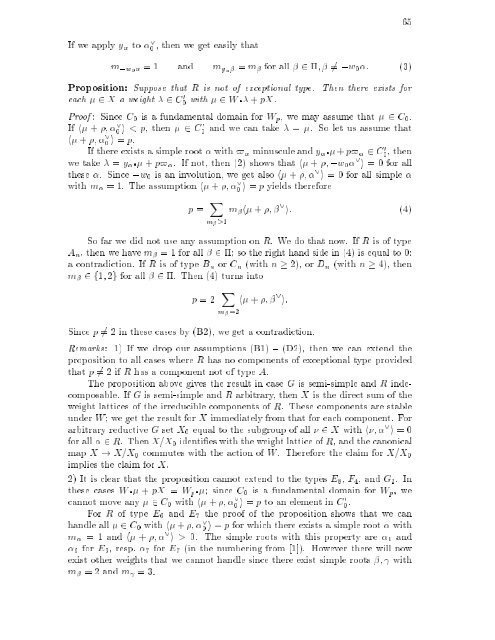subregular nilpotent representations of lie algebras in prime ...
subregular nilpotent representations of lie algebras in prime ...
subregular nilpotent representations of lie algebras in prime ...
Create successful ePaper yourself
Turn your PDF publications into a flip-book with our unique Google optimized e-Paper software.
If we apply y to _ 0 , then we get easily that<br />
m,w0 =1 and my = m for all 2 ; 6= ,w0 . (3)<br />
Proposition: Suppose that R is not <strong>of</strong> exceptional type. Then there exists for<br />
each 2 X aweight2C0 0 with 2 W + pX.<br />
Pro<strong>of</strong> : S<strong>in</strong>ce C0 is a fundamental doma<strong>in</strong> for Wp, wemayassume that 2 C0.<br />
If h + ; _ 0 i 1<br />
65<br />
m h + ; _ i: (4)<br />
So far we did not use any assumption on R. Wedo that now. If R is <strong>of</strong> type<br />
An, then we havem = 1 for all 2 ; so the right hand side <strong>in</strong> (4) is equal to 0:<br />
a contradiction. If R is <strong>of</strong> type Bn or Cn (with n 2), or Dn (with n 4), then<br />
m 2f1; 2g for all 2 . Then (4) turns <strong>in</strong>to<br />
p =2 X<br />
h + ; _ i:<br />
m =2<br />
S<strong>in</strong>ce p 6= 2 <strong>in</strong> these cases by (B2), we get a contradiction.<br />
Remarks: 1) If we drop our assumptions (B1) { (D2), then we can extend the<br />
proposition to all cases where R has no components <strong>of</strong> exceptional type provided<br />
that p 6= 2ifR has a component not <strong>of</strong> type A.<br />
The proposition above gives the result <strong>in</strong> case G is semi-simple and R <strong>in</strong>decomposable.<br />
If G is semi-simple and R arbitrary, then X is the direct sum <strong>of</strong> the<br />
weight lattices <strong>of</strong> the irreducible components <strong>of</strong> R. These components are stable<br />
under W ;we get the result for X immediately from that for each component. For<br />
arbitrary reductive G set X0 equal to the subgroup <strong>of</strong> all 2 X with h ; _ i =0<br />
for all 2 R. Then X=X0 identi es with the weight lattice <strong>of</strong> R, and the canonical<br />
map X ! X=X0 commutes with the action <strong>of</strong> W . Therefore the claim for X=X0<br />
imp<strong>lie</strong>s the claim for X.<br />
2) It is clear that the proposition cannot extend to the types E8, F4, andG2. In<br />
these cases W + pX = Wp ; s<strong>in</strong>ce C0 is a fundamental doma<strong>in</strong> for Wp, we<br />
cannot move any 2 C0 with h + ; _ 0 i = p to an element <strong>in</strong>C 0 0 .<br />
For R <strong>of</strong> type E6 and E7 the pro<strong>of</strong> <strong>of</strong> the proposition shows that we can<br />
handle all 2 C0 with h + ; _ 0 i = p for which there exists a simple root with<br />
m = 1 and h + ; _ i > 0. The simple roots with this property are 1 and<br />
6 for E6, resp. 7 for E7 (<strong>in</strong> the number<strong>in</strong>g from [1]). However there will now<br />
exist other weights that we cannot handle s<strong>in</strong>ce there exist simple roots ; with<br />
m = 2 and m =3.

















